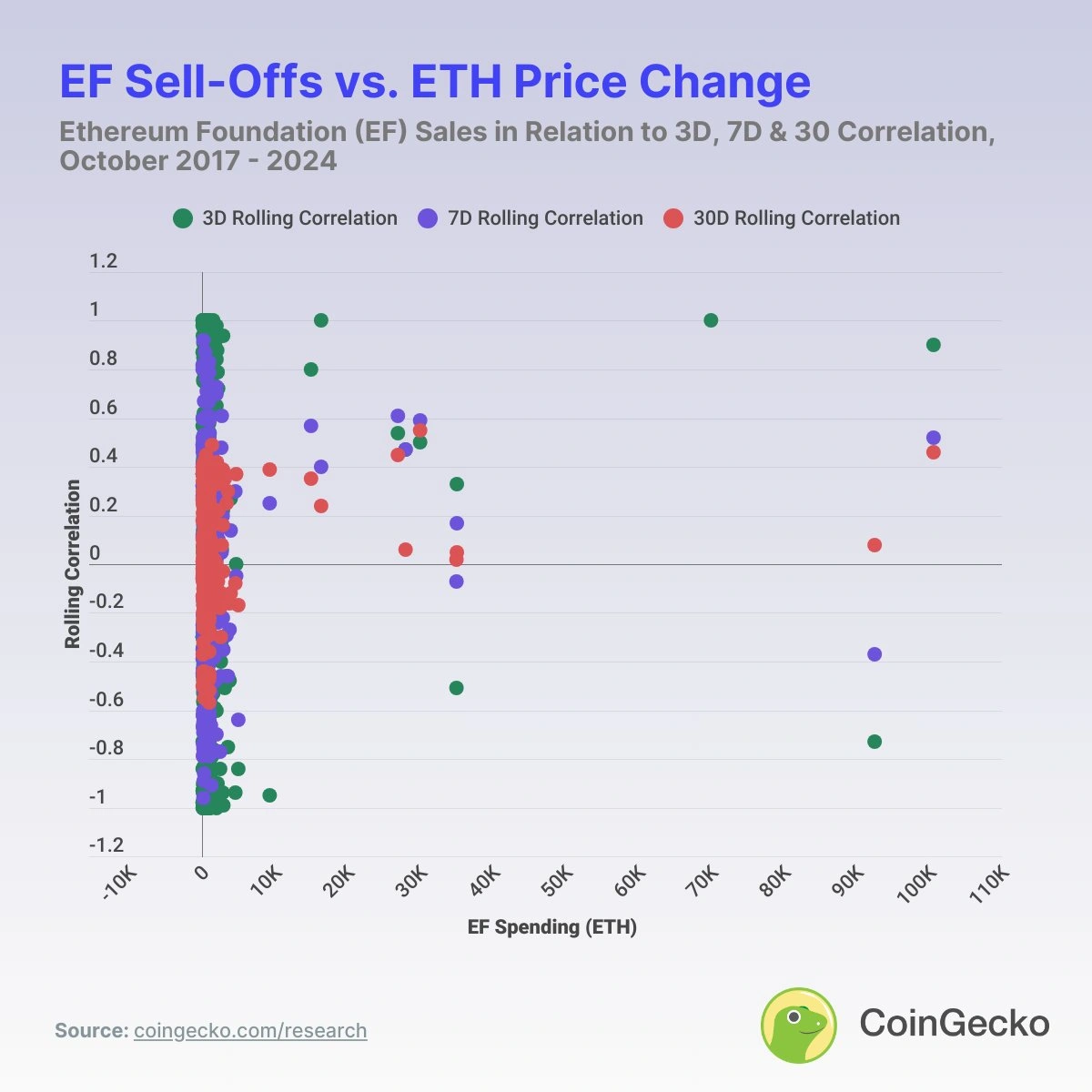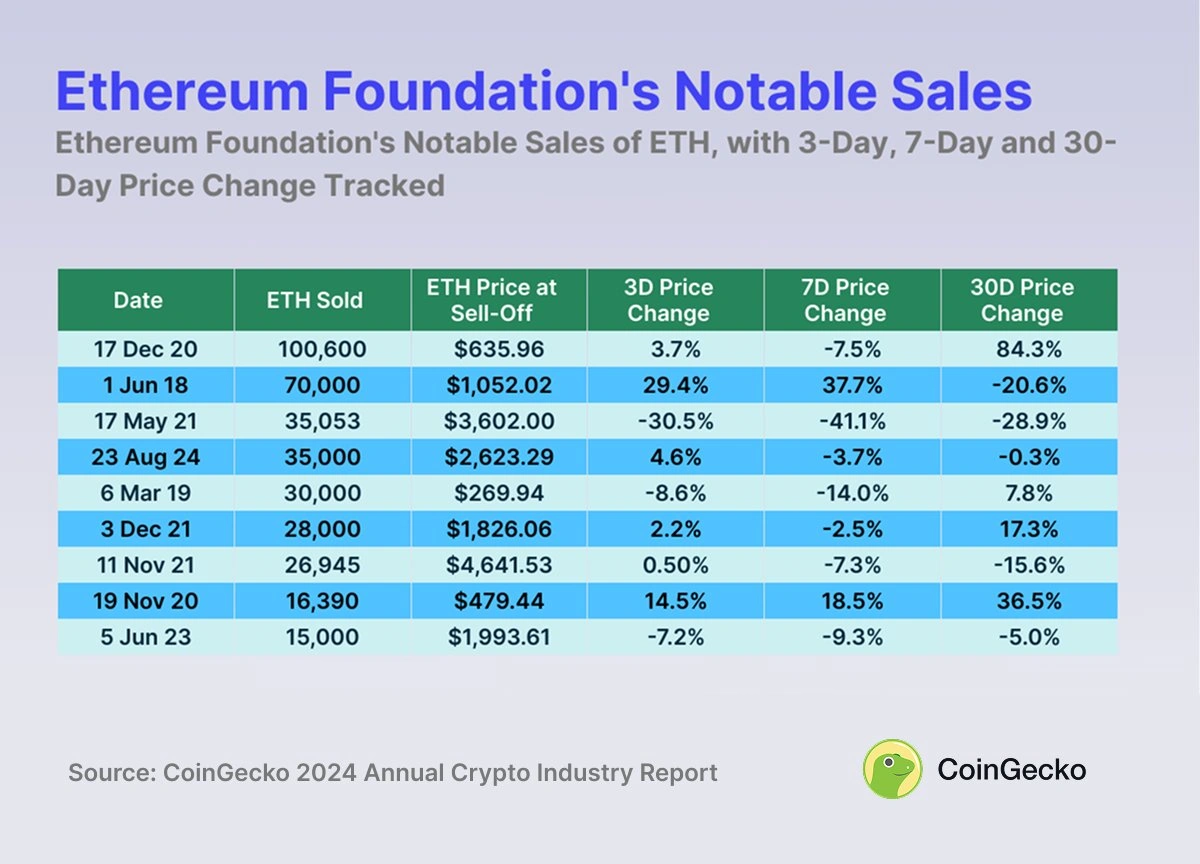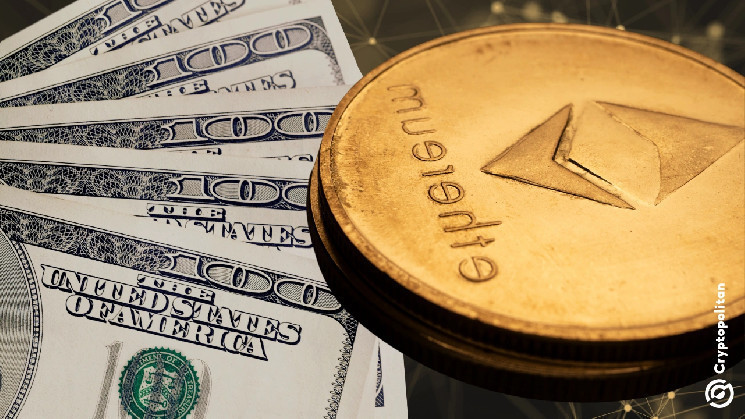Based on an in depth Coingecko report, Ethereum gross sales by the Ethereum Basis (EF) don’t considerably have an effect on token costs as generally believed.
“Does the sale of Ethereum Basis (EF) trigger vital market actions?” Coingecko requested in a tweet. There, we uncovered the most recent analysis that proves that the sale of Ethereum Basis of ETH under 9k is just not considerably positively correlated with value modifications.
The identical can’t be stated for gross sales exceeding 15K ETH. For instance, one instance of the essential promoting 70K ETH was 20.6% DIP, with 16.3K ETH gross sales adopted a 36.5% rise.
For the needs of the investigation, Coingecko analyzed the sale of EFs from October 16, 2017 to January 15, 2025 utilizing publicly obtainable on-chain information from Dune, Etherscan and Coingecko. Observe that solely ETH transactions above 100 ETH are thought of, and the evaluation doesn’t consider market tendencies or macroeconomic occasions.

Ethereum Basis ETH gross sales have had totally different impacts on costs over the three, 7 and 30-day time frames. Supply: Coingecko
Coingecko’s findings verify the connection between EF gross sales and ETH value motion
Based on the report, the common value change for ETH over the seven days after the sale of ET is +1.3%. The report doesn’t disprove the declare {that a} huge sale of the Ethereum Basis (EF) will set off a direct market response. Nevertheless, they argue that these actions are usually not uniformly unfavorable.
The share of circumstances the place ETH costs have fallen inside seven days of the sale of EF is -47.6%, suggesting that lower than half of EF gross sales will lead to quick value drops. The truth is, Coingecko argued that usually EF gross sales actions don’t trigger deep diving in Ethereum costs.
Because the sale was made, the most important weekly decline on file after EF gross sales was -41.1%.
Some gross sales result in distinguished short-term responses. For instance, a sale that occurred on Could 17, 2021 induced costs to plummet inside per week at -41.1%.
Coingecko argues that such ranges of decline are usually not common as different massive transactions can as a substitute coincide with value will increase. Additionally, regardless of the large sale, ETH costs noticed pumps in 164 circumstances, however fell to 149 circumstances.
The blended outcomes are proof that EF spending is just not a dependable ticket to a bloody ETH chart.
Over the 30-day vary, the muse’s sale after a mean ETH value change is +8.9%.
Ethereum Basis spending varies with ETH costs throughout totally different time frames
To additional discover the connection between EF expenditures and ETH value motion, Coingecko analyzed the rolling correlation over three time frames: 3 days, 7 days, and 30 days.

Gross sales from the well-known Ethereum Basis. Supply: Coingecko
Knowledge revealed that the rolling correlation over the 3-day ranged from -0.999 to +0.999. This means excessive volatility, suggesting that short-term value actions could possibly be strongly influenced by broader market situations slightly than EF expenditures.
One case confirming this occurred was on November 19, 2020, when the rolling correlation reached 0.9998 after EF offered 16,390 ETH and the value of the ETH rose from $479 to $560 over 4 days.
After all, EF was offered and ETH might endure a value drop over the subsequent three days.
Nevertheless, in each circumstances, the short-term correlation proves that it’s extremely delicate to market sentiment and fluidity, slightly than what the Ethereum Basis does with ETH reserves.
Not like the 3-day correlation, the 7-day rolling correlation has much less volatility and usually varies between -0.7 and +0.7. This reveals a extra steady however inconsistent relationship between EF expenditures and ETH costs over the weekly timeframe.
The 30-day rolling correlation supplies perception into broader market tendencies. For instance, between 2018 and 2020, the correlations are primarily optimistic, usually above 0.3.
Which means EF funding actions could also be associated to market belief and development, significantly in the course of the early phases of ecosystem enlargement, within the naked market.
Nevertheless, since 2021, the correlation has regularly flowed to impartial or unfavorable values, a change that displays the influence of Ethereum’s market maturity and higher macroeconomic energy.
So far as gross sales distribution is worried, there is no such thing as a vital optimistic correlation between modifications in ETH costs and gross sales of ETH under 9K. Nevertheless, it’s reported that when extra ETHs are offered, stronger optimistic correlations will seem usually.
Coingecko evaluation revealed that the 30-day rolling correlation between EF expenditure and ETH costs was concentrated primarily between -0.3 and 0.5, indicating a weak to average relationship.
The 7-day rolling correlation follows the same distribution, however reveals extra variation, whereas the 3-day rolling correlation is extra excessive, with excessive concentrations highlighting a pointy however inconsistent short-term response to EF gross sales.
All of those findings verify that long-term correlations are weak and inconsistent when Ethereum Basis gross sales usually have an effect on value actions within the short-term timeframe.












